
Editor’s note: James Altucher is an investor, programmer, author, and several-times entrepreneur. His latest book, “Choose Yourself!â€Â (forward by Dick Costolo, CEO of Twitter) came out on June 3. Follow him on Twitter @jaltucher.
My most recent book, “Choose Yourself!†sold 44,294 copies in its first month out, hit the Wall Street Journal Bestseller list, was No. 1 on Amazon for all non-fiction books for a few days and is still flirting with No. 1 in its various categories. This post is about what I did differently, why I did it differently, and how I think anyone can do this to self-publish a bestseller. I describe all the numbers, who I hired and why, and how I made the various choices I did.
Every entrepreneur should self-publish a book, because self-publishing is the new business card. If you want to stand out in a world of content, you need to underline your expertise. Publishing a book is not just putting your thoughts on a blog post. It’s an event. It shows your best curated thoughts and it shows customers, clients, investors, friends and lovers what the most important things on your mind are right now.
Unfortunately, most people suck at it. I’ve largely sucked at it. I’ve published 11 books â€" five with traditional publishers and six that are self-published.
The distinction now is no longer between “traditional publishing†versus “self-publishing.†The distinction now is between professional versus unprofessional publishing. My first 10 books were done unprofessionally. Even the ones with the big publishing houses. They will probably hate me now. I hope not. I really like the people I worked with at these publishers.
I hope that everyone self-publishes. The benefits are enormous:
More money. Unless you are a John Grisham or E L James you will make much more money by professionally self-publishing. It’s not just money on sales but also foreign rights and special packages that you can offer if you control all the rights to your work. Packages that the traditional publishers almost never go for.
Control over design. Traditional publishers usually keep that control.
Speed. You will probably speed up your publication date by over a year or more if you self-publish.
Content control. My bet is close to 100 percent of the people reading this post have content in them strong enough for a book. But 22-year-old interns at publishing companies won’t recognize that content. Even the editors, the publishers, the marketing guys â€" most of them â€" will not recognize the message you have to offer. Which leads me to…
Avoiding bad things in life. I hate getting that feeling of, “I hope he or she chooses me for X.†Where “X†could be an investment, an acquisition, publishing a book, buying my product, whatever. I try to limit this feeling in my life whenever possible. When you have to deal with more and more layers of people who have to choose you, you don’t get the opportunity to choose yourself (!), which is infinitely more valuable.
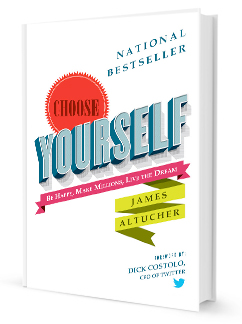 Enter Publishing 3.0: How To Professionally Self-Publish Your Next Book
Enter Publishing 3.0: How To Professionally Self-Publish Your Next Book
Here’s what I did step-by-step with my latest book for the first month since publication.
1) Build your platform
A traditional publisher is not even going to look at you unless you have your own platform, which means a Twitter following, Facebook following and/or a significant blog following. But if you already can hand-deliver the customers, what do you need the traditional publisher for?
Wasn’t that supposed to be what the publishers would get for you? Don’t they get you in bookstores? The answer is “no.â€
Bookstores take very few of the books published by publishers. And whenever you see a book facing forward, or on the front table, or a “staff pick†that means the publisher usually paid to have that special placement. Most books don’t get this. And if you don’t get that, chances are your books won’t sell.
2) How do you build your platform?
Have an honest voice. Don’t be afraid to say things about either yourself or your industry. Provide unique perspective. If it doesn’t bleed it doesn’t lead. Make sure every post or video you do bleeds from the heart, entertains, and educates. In that order.
How do you get traffic? Blog on bigger sites that aggregate bloggers or podcasts or whatever. It takes time to build up. But sincere voices will always rise to the top.
3) Write
This is not a post about writing or how to write a good book. The assumption is that you will write a good book. BUT, two tips: write 500-2000 words every day to keep exercising the writing muscle. And read good writers every day. Then you will write an even better book.
A typical book is anywhere from 40,000-80,000 words. So if you can average 1,000 words a day, seven days a week, you can write four to eight books a year. Or one very very good, edited, revised, professional one. Or 10! Knock yourself out!
I also wanted a high-quality forward for the book. I was really grateful that Dick Costolo, CEO of Twitter, agreed to do mine. I realize why he used to be an improv comedian when I read what he wrote.
4) Know What You Want
If you are self-publishing then you can publish your book right now without any other effort. Go to CreateSpace (owned by Amazon), check the box that you want to be both paperback and Kindle (it costs an extra $69 to be on kindle), pick a cover, upload your manuscript, and in a few days you will be published on Amazon and people can start buying your book.
If your goal is to have a published book and use it to get customers, consulting gigs, speaking gigs, etc., or a beginning set of readers for your next book, then by all means publish this way. It’s the fastest way to do it. I highly recommend it.
But if your goal is to put out the best possible product, maximize the money you make, and get the most readers, then follow the next steps, what I call “Publishing 3.0.â€
- 1.0 was publishing with a traditional publisher.
- 2.0 was when the stigma of self-publishing went away and an entire new artistic outlet was open to millions of people (15 million books published last year versus 300,000 10 years ago). It’s cheap, quick, and easy to get your book published.
- 3.0 is starting right now â€" where you can self-publish better, more successfully, better edited, better designed, better marketed, and make more money than if you go any other route. The reason this is possible only now is because for the first time, the best editors, designers, marketers are no longer working at the big publishing houses. Instead, they are striking out on their own and independently charging for their services. The demand is there. This route is more expensive than “publishing 2.0″ but is much more lucrative.
5) Editing
Previously my editing was just a spell check. And that was more than some of my mainstream publishers did. My wife asked me if I was kidding on this. But I told her to read my second book and she stopped questioning it. In other words, it was awful.
With my latest book, I went all out. I hired two copy editors to go through the basics on spelling and grammar. Then I hired Command Z Editing, run by Nils Parker, to help me structurally edit, i.e. do the job that editors used to do (example: Maxwell Perkins in the 1930s) but have been sorely lacking in the past 20 years from traditional publishers. Nils has previously edited bestsellers from Tucker Max, Kamal Ravikant, Ryan Holiday, and a dozen writers, as well as written screenplays, books, etc.
Nils and I went back and forth on more than 15 different rewrites for my book. The difference between the original version and the final version is like the difference between chicken shit and chicken salad.
I am not saying “hire Nils†by the way. I’m just saying this is who I used (and paid). Make sure who you use is among the best in the world, or else you aren’t taking advantage of what the Publishing 3.0 world has to offer. Nils and I went back and forth on more than 15 different rewrites for my book. The difference between the original version and the final version is like the difference between chicken shit and chicken salad.
And yes, publishers have editors. Some very good ones. But I specifically wanted to choose my own editor and use an editor that has worked on books that have sold millions of copies. The entire idea of “Publishing 3.0″ is that I am not limited to who is on the publisher’s staff but I can pick the absolute best people in the industry. With millions of books out there, the competition is incredible.
Hiring the best editor, design firm, marketing firm, and audio firms were all part of that. Not just the best around but who I felt were the best in the world.
6) Design
I never liked any of the designs on my traditionally published books, but I had no control over them. I don’t mean this to sound so anti-publisher. But they were busier with bigger authors, and I don’t think they were always able to devote resources to me.
I made sure I put out a product I could be proud of. I used Erin Tyler Design who helped me find the right cover designer, and she also managed the interior design process, which was a lot trickier than I thought.
She designed the spine, picked the fonts, the inside flaps, the back cover, and all the quirks â€" tables, pictures, asides, etc. â€" inside the book and then helped format for when I uploaded to Kindle Direct on Amazon.
7) Audiobook
I was at a dinner that Amazon had for self-published authors last October.
One guy who was making a solid living self-publishing science fiction novels told me that he always made an audiobook. I thought that was a horrible idea, and told him so.
But two things about audiobooks:
- He said, “When people see you have an audiobook, they see your book as even more credible. It stands out from the average self-published book when you have an e-book, a print version, and an audiobook. Plus, the audio book is more expensive, so even though there are fewer sales, it’s decent money.†By the way, if you self-publish, always do a print book at the very least. Even if 99 percent of your sales are going to be e-book.
- I asked the head of an ad agency what marketing tips he had for my upcoming book. He said, first thing, “Make an audiobook. For your kind of book, people will love listening to it while they drive into work.â€
So Claudia, my wife who has been supportive of every aspect of this effort, set up her office in our house to be a mini-recording studio. I wrote to Tucker Max that I was going to make an audiobook. He wrote back:
“James, where are you doing the audio, and who’s editing it? Please tell me you aren’t just doing it yourself with your Mac and a mic you bought online.â€
We looked at our Mac and a mic that we had just bought online and decided to go to a professional studio. Tucker suggested John Marshall Media. They had done audiobooks ranging from President Clinton’s autobiography to the Harry Potter books to Freakonomics.
It was a thoroughly annoying experience but it was worth it.
I felt uncomfortable just sitting there for eight hours reading words I had written. For one thing, it hurt. Reading for eight straight hours was killing my throat.
Second, I didn’t want to just read stories I had already written. So I did it totally unabridged and improvised quite a bit, making it somewhat original compared to the book.
But the best reason for doing the audiobook is it forces you to really look at your writing and hear what works and what doesn’t. I rewrote about 20 percent of the book after reading things that didn’t quite sound right out loud.
It meant another round of edits (with the help of Nils) to improve the book, a process I never would have gone through if I hadn’t done the audio version.
8) Title
This deserves its own category. I had total control over the title. My first choice for the book was “The Choose Yourself Era.†But whenever anyone asked me to say the title I had trouble saying it. “Era†sounds like “Error.†One person asked me if it was going to a book about archaeology. So somehow it wasn’t working.
So I picked 10 titles that I liked, combined them with the cover and created Facebook ads that I sent out to all my friends and friends of friends in the U.S. Then I sat back and watched the click-throughs. After a few days and thousands of click-throughs I had my title.
“The Choose Yourself Era†came in a distant third place. “Pick Yourself!†was right above it in second place. And “Choose Yourself!†came in first by far.
I then took the same Facebook approach to pick the subtitle and the final version of the cover design.
Results of the Facebook Title test:
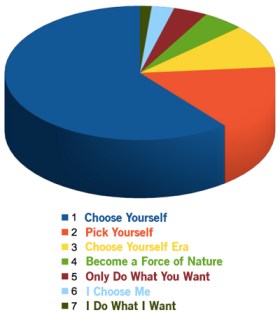
Â
9) Marketing
I used Ryan Holiday’s company Brasscheck. Ryan is the head of marketing for American Apparel, and has marketed many bestsellers, including books by Tim Ferriss (“The Four Hour Chefâ€), Robert Greene (“Masteryâ€), Tucker Max (“I Hope They Serve Beer in Hellâ€), and others.
I had never before used an outside agency, always trusting either my own basic platform or a publisher. What Ryan provided was unbelievable. Between his Rolodex and mine we scheduled about 60 podcasts, radio interviews, speaking engagements and guest posts on popular blogs and websites.
There were also some other things that I would not have been able to coordinate: A Reddit AMA that got over 3,000 comments and probably close to a million views over the past month. His company created a SlideShare presentation that became the most viewed SlideShare on the site the week of the launch with over 300,000 views. My schedule the month after launch was non-stop marketing. I was burnt out by the end of the month.
I had also become a fan of Bitcoin. So I set up bitcoin.chooseyourself.us a month before I released the book and became the first book ever pre-released solely on bitcoin. Ryan then got several key media sources to cover this.
I offer to pay people back for the book if they could prove to me that they bought it and read it.
I also wanted to market an offer in the beginning of the book. My goal was not to necessarily make the most money but to make sure the message reached as many people as possible. So on the very first page, before the editorial information and dedication, there is “the offer.â€
I offer to pay people back for the book if they could prove to me that they bought it and read it. Then I would pay them back completely for the book (losing money on each transaction because of the cut Amazon takes plus shipping). The idea was I would be happy to give the book for free, but I know people don’t value things they get for free. And I also know most people don’t read the books they buy. Hence the offer.
Ryan was successful at making sure that the offer itself was covered in various media outlets.
Brasscheck also scripted the video trailer that was produced and animated by Simplifilm. I describe the results of the marketing below.
10) Foreign Rights
I found with my prior books that the traditional publishers would more or less wait for foreign publishers to call and then they would sell the rights and my split would be minimal. Typically the split was 50-50, but out of my 50 would come my agent’s split. I was competing with too many of the other authors in the publisher’s stable to get any attention from foreign publishers.
Now I own all the rights to my book. Most people who self-publish aren’t thinking foreign rights. You still have to have someone who is going to be your advocate with the foreign publishers. So I got a foreign rights agency, 2 Seas Agency, to handle all of the foreign rights on a commission basis. They go to book conferences all over the world and have connections in each country.
In June, the first month the book was out, Marleen Seegers from 2 Seas sold rights to: Brazil (USD 2500), China (USD 4300), Korea (USD 5000). She is currently in negotiations with publishers from 10 other countries. The three mentioned above are where  the contracts were finished blindingly fast.
11) Other Merchandise
Since I own the rights I can do whatever I want. Below in the “Numbers†section I describe a bundle I put together combining a hardcover version of the book with three earlier books plus some original writing that was sent out by an e-newsletter company that did all of the fulfillment and split the proceeds with me.
With the help of The Social Pages and Litographs I also made a poster that is designed like the cover of the book when you look from afar but when you get close to it you see clearly all 67,000 words of the book.  I’m also making that into a shirt. What will I do with it? I have no idea. But it’s fun and I wanted to do it.
In the below photos you can see the far away version and the words when you are standing about an inch from the poster.
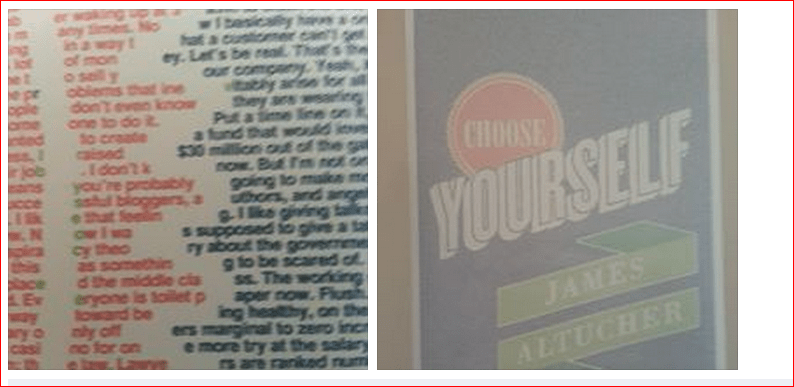
12) The Numbers
First off, what were my prior numbers? Here are my advances on my first mainstream-published, five books in order: $5,000, $7,500, $30,000, $100,000 and $30,000. Advances are coming down quickly!
My first book made back my advance and with about a 10 percent royalty I probably made another few thousand dollars on it. None of my other books came close to making back their advances.
I don’t have all the numbers on my first five self-published books, but I gave an enormous number of books away for free in order to build up my readership. Almost all of those books I produced for free but my revenues were minimal even though I had many readers for them.
In the first week “Choose Yourself!†was out I made the WSJ Bestsellers List with about 10,000 copies sold. To hit the New York Times bestseller list I can tell you anecdotally (and it depends on the week) that you need about 2,500-3,000 copies sold in your first week. I couldn’t get on the NYT Bestsellers List because they do not look at books that do not appear in bookstores. I’m not in any bookstores at the moment, although I’m working on ways that can change. Suffice to say I would have hit that list as well as the WSJ list.
In the first month I sold 44,294 copies between my paperback, audio, e-book, and even hardcover versions.
The hardcover version was sold via an email newsletter, run by Porter Stansberry, that bundled the hardcover with three free versions of my past books plus an original report written by me. He split the proceeds 50-50 with me after the cost of the hardcover was recovered. I sold about 20,000 through this method in the first month. Email marketing is almost never attempted by mainstream publishers.
Of the remaining 24,000, close to 50 percent was Kindle, 45Â percent was CreateSpace and 5Â percent was Audible. On all the Amazon Kindle sales, the royalty is 70Â percent of the $4.99 cost. On the Audible version the royalty is approximately 52 percent, give or take a few percentage points. On CreateSpace the royalty given my pricing was about 26Â percent.
The total cost of everything described above was $31,000 (which can be reduced significantly depending on your specific needs. For instance, not every book needs an audio version and a video trailer), not counting traveling I did for the marketing and other marketing costs involved in building my platform.
I am happy to answer questions about the process in the comments below.
[Top image: Shutterstock]
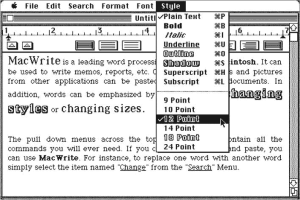 “Quip is a modern word processor optimized for the era of tablets and phonesâ€, Taylor tells me. We’re in the middle of a transition away from the desktop computer, yet word processors have stagnated. For dramatic effect, Taylor dropped a screenshot of MacWrite (shown to the right) into the Quip introduction post, and told me “It’s comical how similar that looks to what we use today.â€
“Quip is a modern word processor optimized for the era of tablets and phonesâ€, Taylor tells me. We’re in the middle of a transition away from the desktop computer, yet word processors have stagnated. For dramatic effect, Taylor dropped a screenshot of MacWrite (shown to the right) into the Quip introduction post, and told me “It’s comical how similar that looks to what we use today.â€ First it adapts documents to whatever size or shape screen you’re working on. If you’re on an iPhone, an embedded photo could appear full-width, but on an iPad it would appear on the right surrounded by text.
First it adapts documents to whatever size or shape screen you’re working on. If you’re on an iPhone, an embedded photo could appear full-width, but on an iPad it would appear on the right surrounded by text.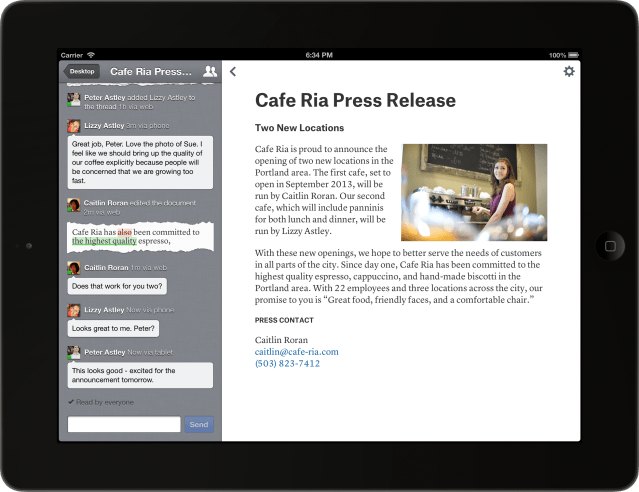
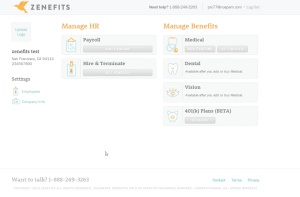




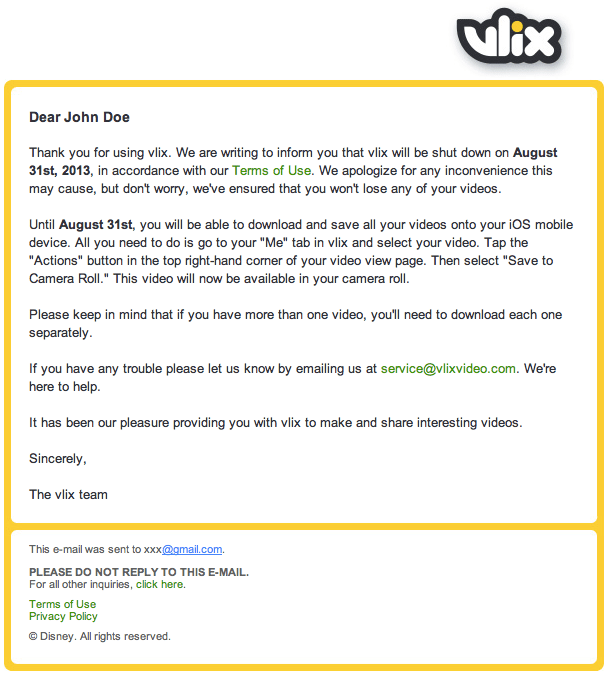

 Enter Publishing 3.0: How To Professionally Self-Publish Your Next Book
Enter Publishing 3.0: How To Professionally Self-Publish Your Next Book

Will Google still have anything up their sleeve to announce this morning? Tune in to find out.
The event is scheduled to start at 9 A.M Pacific (That’s noon Eastern, 1 A.M. Tokyo, and 5 P.M. London), but tune in early!